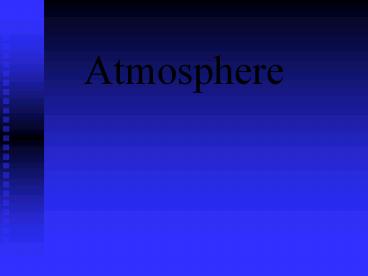Atmosphere - PowerPoint PPT Presentation
1 / 29
Title: Atmosphere
1
Atmosphere
2
Composition of the Earths Atmosphere
- The atmosphere is a mixture of gases with some
suspended solids and liquids. - Nitrogen is the most common gas at 78 of the
atmosphere. - Oxygen is the next most common gas at 21
3
Composition of the Atmosphere
4
Earths Atmosphere
- Trace amounts of other gases are found that total
only 1 water vapor, Carbon Dioxide, Neon,
Methane,Ozone, Hydrogen, Helium
5
Other Planets Atmospheres
6
Earths Atmosphere
- Brown Smog is made from nitrogen oxides and
hydrocarbons. (L.A. type) - Gray Smog is from burning coal or oil and
contains sulfur oxides. - Ozone is a pollutant when it is near the ground.
It is in most smogs.
7
Structure of the Atmosphere
- There are five main layers in the atmosphere.
- The lowest layer is the Troposphere.
- The Stratosphere and Mesosphere are the next
highest layers. - The Thermosphere and then the Exosphere are the
highest layers.
8
Layers of the Atmosphere
9
Layers of the Atmosphere
- A. The Troposphere
- 1.Close to the ground
- 2. Contains 75 of the Earths gases.
- 3. Weather, clouds and smog occur at this level.
- It ends at 10 Km above sea level.
10
Layers of the Atmosphere
11
12
Layers Of the Atmosphere
- B. The Stratosphere
- The ozone layer is within the stratosphere. It
is a thin layer of O3 which absorbs UV radiation. - C. The Mesosphere is the middle layer.
- D. The Thermosphere contains the ionosphere. The
ionosphere is a layer of electrically charged
particles. Radio waves bounce off of it. - E. The Exosphere is the highest level before
space.
13
Atmospheric Pressure
- Gases in the atmosphere have mass and weight.
Gravity pulls on the molecules and causes
pressure. - Pressure is force exerted on an area.
- P F/A
- At sea level there are more molecules of air
above an area, so there is more pressure.
14
Units for Pressure
- The S.I. Unit for pressure is Atmospheres (Atm)
- The old unit used on T.V. is inches Hg
- ( Which is mercury)
- A metric unit is mm Hg ( millimeters)
- Another unit used is millibars (mb)
15
Temperature in the Atmosphere
NAME Height (Km) Temperature (Celcius)
Exosphere 500 Km 600-1000
Thermosphere 200 - 500 0-600
Mesosphere 50 -150 -5 to 0
Stratosphere 10 - 50 -60 to -5
Troposphere 0 10 -60 to 50
16
The Ozone Layer
- 20 Km above sea level
- Ozone is 3 atoms of oxygen.
- Located in the Stratosphere.
- Ozone absorbs UV radiation from the sun.
- ODPs Ozone Depleting Gases
- CFCs are ODPs Chlorofluorocarbons
- CFCs break the ozone down to oxygen molecules
17
Energy from the Sun
- Radiation is the transfer of energy by
electromagnetic waves. EM waves - 30 of the radiation from the sun is reflected
off of the Earth. - 50 of the radiation is absorbed by Earths
surface. - Clouds and the atmosphere absorb 20 .
18
Energy Transfer in the Atmosphere
- Conduction the transfer of energy when
molecules bump into one another. - Air near the heated surface of the Earth is
heated by conduction.
19
Energy Transfer
- Convection - the transfer of heat by the flow
of materials. - Heated air is less dense and rises, cold air
sinks. This flow of air is called a convection
current.
20
The Water Cycle
- The Hydrosphere All of the water on the Earths
surface. - 97 of water is salt water, only 3 is fresh.
- 67 of the fresh water is frozen at the polar
ice-caps , which are 2 miles thick in some
places.
21
The Water Cycle
22
The Water Cycle
- Water evaporates and becomes a gas.
- The evaporated water rises in the atmosphere.
- As the water rises, it cools.
- As the gaseous water cool, it condenses to form a
liquidclouds. - Precipitation is next the water falls as rain,
snow, sleet, or hail.
23
Water Cycle
- Water is recycled constantly.
- Water is purified through the water cycle.
24
Movement of Air
- Wind is caused by the uneven heating of the
Earths surface and atmosphere. - Areas of temperature difference create areas of
pressure difference. - Wind is the movement of air from areas of high
pressure to areas of low pressure.
25
Movement of Air
- The Coriolis Effect the rotation of the Earth
shifts the wind to the right and north. - The Jet streams high altitude, strong winds.
The flow west to east in the U.S. - The Jet stream has a major effect on weather.
26
Movement of Air
27
Movement of Air
- Sea Breezes created during the day because
solar radiation warms the land more than the
water. It comes in from the sea.
28
Movement of Air
- Land Breezes created at night, cold air over
the land forces up the warmer air over the sea.
The wind goes out to sea. - Monsoon winds are seasonal winds that occur in
tropical areas. ( This creates a wet, very rainy
season.)
29
Tools of Meteorology
- Anemometer
- Barometer
- Psychrometer
- Rain Gauge
- UV Meter
- Weather Satellite
- Weather Balloon































